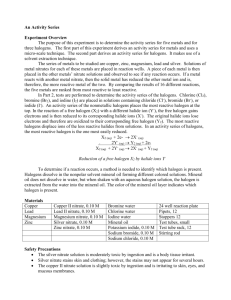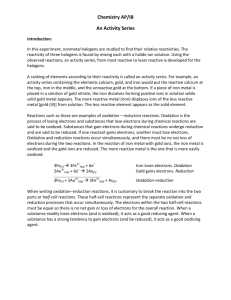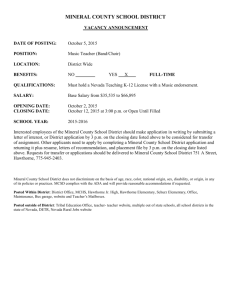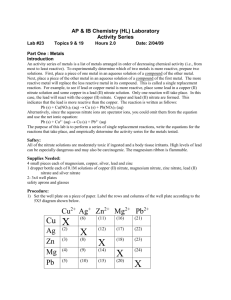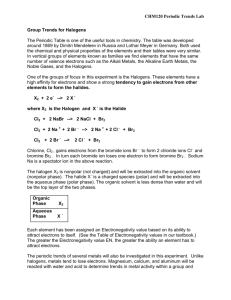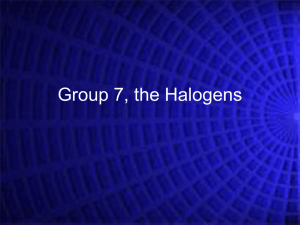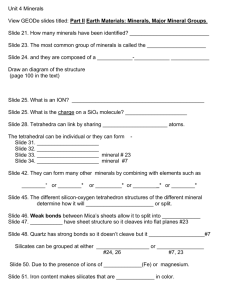File - Toby Johnson
advertisement
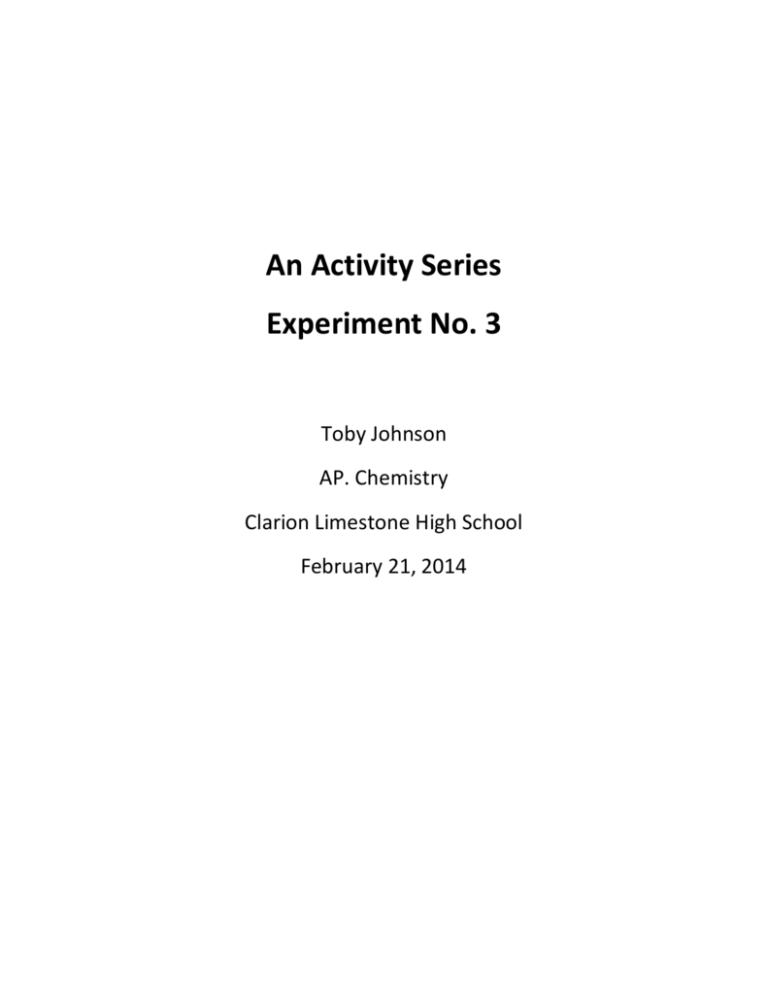
An Activity Series Experiment No. 3 Toby Johnson AP. Chemistry Clarion Limestone High School February 21, 2014 Abstract: In this experiment I was able to find the relative reactivities of metal and nonmetal halogens. The procedure for this experiment was divided into two parts. I first found the activity series for metals and then I found the activity series for the halogens. For part one I first obtained a 24well plate and then I added drops of each solution in the wells instructed. Once that was done, I then placed the metals given in each of the wells and determined if a reaction took place. For part two I obtained test tubes and added drops of the solutions given by the instructions and then added mineral oil and shook the test tubes. During part two I first found the colors of the halogens in the mineral oil and the halide ion. Then once that was found I was able to determine if a reaction took place after using the test tubes again. Based on the results I found, I was able to develop the activity series from the metals given in the lab. Apparatus: Throughout this experiment two main instruments were used to obtain my results for the metal and halogen activity series. In part one of the experiment I used a 24-well plate to determine if a reaction occurred when a solution and metal was added to a well. In part two we used test tubes to determine the color of the halogens and halide ions in the mineral oil, so I could then determine whether or not a reaction took place after adding the solutions and mineral oil and shaking the solution. Both of these instruments were very helpful in containing the solutions and making sure an error was less likely in the experiment process. Theory: For part one of this experiment I placed a piece of metal into another metals solution to observe if a reaction takes place. If a reaction does take place I know that the metal reduced the other metal ion and is the more reactive metal of the two. Then for part two I determined what color a halogen looks like dissolved in the nonpolar solvent mineral oil. Then knowing what color the halogens produce in the mineral oil, I then made several aqueous halogen solutions and added the mineral oil and observed the color change. I knew that once shaken the halogen is extracted from the water into the mineral oil showing a color, which indicates which halogen is present. Procedure: Starting this experiment off I first obtained a clean 24-well plate and placed it on a piece of white paper so I would be able to determine if a reaction occurred easily based on the white background. I then labeled the columns one through six and the rows A through D on the well plate. I then put one milliliter of copper (II) nitrate solution into wells B1, C1, and D1 in the first column. Then I added one milliliter of magnesium nitrate solution into wells A2, C2, and D2 in the second column. Next was one milliliter of lead nitrate solution into wells A3, B3, and D3 in the third column, then zinc nitrate A4, B4, and C4 in the fourth column, and finally sliver nitrate into wells A5 through D5 in the fifth column. Once each of the solutions were put into each of the designated wells I began to put the metals in each of the wells. Copper metal was put into the first row, magnesium metal into the second row, and zinc metal into the fourth row of the solutions. I then submerged each of the metals into the solutions by using a stirring rod and allowed each solution to stand for five minutes. After waiting for the solutions to mix I was then able to determine if a reaction had occurred in each of the wells and determine the activity series for the metals. In part two of this experiment I had to determine an activity series for some halogens. I took a milliliter of chlorine water, bromine water, and iodine water and put each of them into three separate 10 mm test tubes. Once each of these solutions were in the test tubes I then added a milliliter of mineral oil to each test tube, corked the tube, and then shook each of the test tubes for ten seconds. From this step I was able to see what color appears when each halogen is dissolved in mineral oil. The next step was to test to see of the halide ions give a color to the mineral oil. I put sodium chloride, sodium bromide, and potassium iodide solutions into three separate test tubes and then I added mineral oil to each tubes, corked the tubes, and the shook each of the test tubes for ten seconds. I then recorded the colors given off by the mixture of the solution. Next I set up six new clean test tubes in a test tube holder and labeled each of them 1 through 6. For the next last steps I had to react each halogen with other two halide ion solutions to determine if the ions reduce the halogens. First I placed a milliliter of sodium bromide solution into test tube 1 and potassium iodide into test tube 2 and added chlorine water and mineral oil to each. Once the solutions were added I corked each and shook to mix the solutions. I then recorded each of the solutions results. I then repeated the same test using bromine water and using sodium chloride and potassium iodide to test tubes 3 and 4. After I recorded the next results I then repeated the same test for iodine water with sodium chloride and sodium bromide to test tubes 5 and 6. Once the solutions settled I recorded whether or not a reaction had occurred. Data Tables: An Activity Series for some Metals. Cu(s) Cu+2(aq) X Mg+2(aq) No Reaction Mg(s) No Reaction X Pb(s) Liquid turned green and slight tarnish Liquid turned green and slight tarnish No Reaction X No Reaction Slight tarnish Tarnished and dissolved X Zn(s) Pb+2(aq) No Reaction Zn+2(aq) No Reaction No Reaction Ag+(aq) Turned green Turned black and dissolved Turned black and dissolved Turned black and dissolved Part 2: An Activity Series for some Halogens. Halogen Chlorine Bromine Iodine Color in Mineral Oil White Orange Pink Halide Ion Sodium Chloride Sodium Bromide Potassium Iodide Color in Mineral Oil White White Yellow Cl2(aq) x Yellow, Reaction Pink, Reaction Br2(aq) Orange, No Reaction x Purple, Reaction I2(aq) Pink, No Reaction Pink, No Reaction x Reaction Data Table Reactants Cl- (aq) Br- (aq) I- (aq) Conclusion: Post -Lab Questions 1. Write the balanced net ionic equations for all the reactions that occurred with the metals. 2Ag+ (aq) + Cu(s) 2Ag(s) + Cu+2 (aq) 2Ag+ (aq) + Mg(s) 2Ag(s) + Mg+2(aq) 2Ag+ (aq) + Pb(s) 2Ag(s) + Pb+2(aq) 2Ag+ (aq) + Zn(s) 2Ag(s) + Zn+2(aq) Cu+2 (aq) + Mg(s) Cu(s) + Mg+2 (aq) Cu+2 (aq) + Pb(s) Cu(s) + Pb+2 (aq) Cu+2 (aq) + Zn(s) Cu(s) + Zn+2 (aq) Pb+2 (aq) + Mg(s) Pb (s) + Mg+2 (aq) Pb+2 (aq) + Zn(s) Pb (s) + Zn+2 (aq) Zn+2 (aq) + Mg(s) Zn(s) + Mg+2 (aq) 2. List the metals in order of decreasing ease of oxidation. Compare this list with an activity series found in a textbook. How do the two lists correlate? Most to least Reactive would be Magnesium, Zinc, Lead, Copper, and Silver and the series does agree in the textbook they are in the correct order. 3. Write reduction half-reactions for each of the metal ions. Arrange the reaction list in order of decreasing ease of reduction. Compare the order with a listing found in a table of standard reduction potentials. How do the two lists correlate? Ag+ (aq) + e- Ag(s) E0=.8 V Cu+2 (aq) + 2e- Cu(s) E0=.34 V Pb+2 (aq) + 2e- Pb(s) E0= -.13 V Zn+2 (aq) + 2e- Zn(s) E0= -.76 V Mg+2 (aq) + 2e- Mg(s) E0= -2.37 V The order of the list follows the order for standard reduction potentials from most positive to most negative. 4. Explain how to determine if a reaction occurs in the halogen experiment. The color of the mineral oil layer shows whether a reaction has occurred or not. If the color of the halogen placed in the solution is present, no reaction has occurred. If the color of the halogen which was originally present as an ion appears the halide ion was oxidized to the halogen. 5. Why should the halide ions not dissolve in mineral oil? The halide ions are charged particles and are polar and they will only dissolve in water, but not in the mineral water since it is nonpolar. 6. Explain what is meant by solvent extraction. How is it used in Part 2? In the solvent extraction the two liquids are shook together. The more polar solutes dissolve more in the more polar solvent and the less polar solutes dissolve in the less polar solvent. The nonpolar halogens in this experiment dissolve more in the nonpolar mineral oil. 7. Write the balanced net ionic equations for the reactions which occurred with the halogens. Cl2(aq) + 2Br-(aq) 2Cl-(aq) + Br2(aq) Cl2(aq) + 2I-(aq) 2Cl-(aq) + I2(aq) Br2(aq) + 2I-(aq) 2Br-(aq) + I2(aq) 8. List the halogens in decreasing order of reactivity. Compare this list with an activity series found in a textbook. How do the two lists correlate? Predict the location of fluorine in this activity series. For the most reactive to least Chlorine, Bromine, and Iodine and the order does agree with the textbook. The halogens become less reactive as the atomic number increases. Fluorine has the smallest atomic number of halogen,s which it will be the most reactive of the halogens. 9. Write reduction half-reactions for each of the halogens. Arrange in order of decreasing ease of reduction. Compare the listing with the order found in the table of standard reduction potentials. How do the lists correlate? Cl2(g) + 2e- 2Cl-(aq) E0= 1.36 V Br2(l) + 2e- 2Br-(aq) E0= 1.09 V I2(s) + 2e- 2I-(aq) E0= .54 V They correlate because the list goes from most positive to least positive. 10. Why was it necessary to test the halide ions for their color in mineral oil? It was necessary because I had to be certain that they didn’t interfere with the color seen from the halogens in the mineral oil. 11. Would it make a difference if calcium bromide solution, CaBr2, is used rather than the sodium bromide solution? Explain. It wouldn’t make a difference because both have bromide ions and the cations are spectator ions. In this experiment I was able to learn how to create an activity series for metals and halogens. I also learned more about oxidation-reductions reactions and got a closer and more of in depth look at how they occur throughout this experiment. Overall my data agreed with the textbook information on the activity series of the metals and halogens. Each of the parts of the experiments went well. I believe it’s possible some error could have occurred due to the solutions being contaminated, took much of one solution or metal, and the chemicals being outdated.
